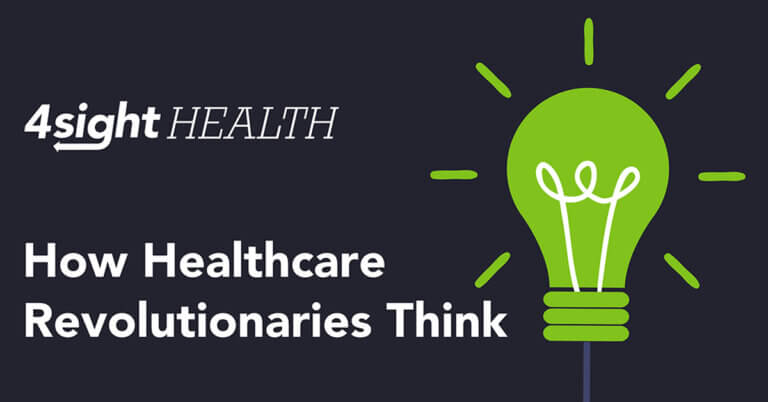May 28, 2020

Healthcare’s Age of Liquid Data: Extreme Interoperability Sparks Personalized, Real-Time, High-Value Services
Key Takeaways
- Healthcare data is in solid form (i.e. fragmented, siloed) and needs to thaw so that it can flow freely to where it provides the greatest benefit.
- Liquid data will be the electricity that powers care optimization, patient engagement and consumerism.
- Platform companies incorporate Aggregation, Curation and Engagement data capabilities to solve consumers’ “jobs” in real time.
- The convergence of 5G connectivity and speed with breakthrough analytics will help revolutionize healthcare delivery.
- Human-machine collaboration will facilitate adoption of new business models that amplify liquid data’s ubiquity, speed and power.
On March 9th, 2020, the Office of the National Coordinator for Health Information Technology (ONC) and the Centers for Medicare and Medicaid Services (CMS) released long-awaited rules governing healthcare data sharing and patients’ access to their health data.[1] This moment was a victory for health data liberation and innovation.
The new rules require health insurers and providers to grant third-party developers access to patient health records, including screenshots, through standardized protocols. They further require providers to inform one another regarding patient admissions, discharges and transfers. Finally, the rules enable patients to get access to their health information through third-party apps that they authorize.
This is an age of unprecedented data capture. Worldwide, 2.5 quintillion bytes of data are created daily, and that number is growing exponentially.[2] A quintillion is a 1 followed by 18 zeroes. Google’s search engine processes 40,000 searches every second.[3] Information on such a scale is not comprehensible without sophisticated technology.
There is no turning back. As happened in 2007 with the release of the iPhone, advances in computational speed, highly scalable data storage, ubiquitous connectivity, advanced analytics, mobile technologies and real-time data sharing are coalescing to create a new paradigm of human-machine collaboration. Our world will never be the same.
Healthcare generates as much or more data than any other industry. Healthcare providers need to leverage artificial intelligence (AI), machine learning (ML), natural language processing (NLP) and other technology tools to collect, curate and analyze massive data sets to improve care delivery, streamline administrative tasks, and glean insights that lead to new and better medicines, treatments and interventions.
As healthcare organizations adopt business models built around consumer-centric platforms, market power will shift away from payers and providers to consumers.
As other vital industries (e.g., banking, telecommunications and transportation) have proven, extreme and secure data interoperability is the essential ingredient required to create technological value. As these new rules go into effect, they will unleash innovation expertise on the nation’s most fragmented, inefficient and consumer-unfriendly industry.
Combined with innovative new technologies and the evolution of 5G connectivity, healthcare is poised for the emergence of Amazon-like platform companies that will revolutionize and personalize healthcare delivery. Healthcare will never be the same.
Liberated, Liquid Healthcare Data Changes Everything

Like all data, health data creates value when it is free-flowing and protected. Once liberated, data becomes more effective and meaningful. It flows to where it can provide the most benefit. Pro-market regulations, like the new data-sharing rules issued in 2020, can level the competitive playing field, stimulate innovation and create value.
With appropriate guidelines and regulations in place, extreme interoperability gets the right data to the right place at the right time in the right format, in a secure manner, so that frontline professionals can make the right treatment decisions in real time. Liquid data will become the electricity that powers care optimization, patient engagement and health consumerism.
Importantly, liquid data with extreme interoperability will empower “platform” health companies to emerge and assemble capabilities that address consumers’ healthcare needs, wants and desires.
Other industries have demonstrated the potential of this mode of platforming. Healthcare can learn from them.
Changes in the banking industry illustrate the incredible power of platforming to revolutionize healthcare. Forty years ago, college students had to cash a check at their local bank by 3 pm on Fridays if they wanted weekend spending money. Beginning in the 1980s, ATMs made cash withdrawals available around the clock.
Today, cash withdrawals, deposits, payments and transfers are a click away through interactive apps on smart phones. Consumers rarely visit a local bank, as access to banking services has never been better, faster or easier. Remarkably, all transactions occur within secure digital platforms.
Healthcare still operates 1980s-era business models without the convenience, capabilities and connectivity that other industries routinely offer consumers. Patient visits occur primarily at physical locations with inconvenient hours and unacceptable delays. This antiquated operating paradigm persists in large part because healthcare companies have failed to develop the data aggregation, analysis and application technologies that drive modern business enterprises.
Healthcare data is fragmented, inaccessible and siloed. It is essentially stuck in solid form and needs to thaw, so that it can flow freely to where it can provide the greatest benefit. The new data sharing rules help provide the sunlight to melt the silos and light the path to interoperability.
Imagine platform companies harnessing the power of these new technologies to redesign and deliver health and healthcare services that meet consumers’ specific needs and preferences.
With liquid data and extreme interoperability, healthcare companies will develop platforms tailored to consumer preferences. Like in banking, platforming healthcare companies will delight consumers with great products and services at competitive prices. Customers will receive greater value and satisfaction for their healthcare purchases.
Unleashing Liquid Data’s Power
Platform companies can unleash liquid data’s power through a three-step process. This interactive process (see chart), aggregates, curates and engages increasingly refined and customized data to solve customers’ problems.
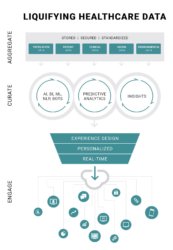
The top layer aggregates stored, secured and standardized population, patient, clinical, social and environmental data. It makes this data readily available in real time to application developers through programming interfaces. Companies curate this data for insights in the middle layer using artificial intelligence, machine learning, natural language processing, bots, predictive analytics and other analytic tools.
The bottom layer applies these insights in customized formats to engage consumers in real time, in a personalized manner based on an expertly designed experience. This happens instantaneously and in a seamless fashion through interactive exchanges between platforms and customers. Improving outcomes and the customer experience are platform companies’ concurrent objectives.
Healthcare data is fragmented, inaccessible and siloed.
As data filters through the process, they create more data and “knowledge” for subsequent exchanges. Interactions among the three layers are continuous and fully integrated.
Through this self-learning process that occurs as the process aggregates, curates and engages data, platform companies are constantly learning more about consumers’ individual preferences. Feedback loops provide new consumer-centric information that the processing funnels aggregate, analyze and apply in new and better ways to enhance outcomes, efficiency and customer experience.
A typical Amazon shopping experience illustrates how platform companies apply data to serve consumers. Amazon collects ubiquitous amounts of data from suppliers, vendors, customers and the marketplace. This data feeds into an analytics layer that matches customer wants to available products.
Consumers engage with the platform through customized apps that learn their preferences, remember their previous transactions and encourage feedback. Amazon improves the quality of these consumer exchanges with transparent pricing, independent product reviews and ratings, product recommendations and 24/7 customer service.
Platform companies use their processing power to manage a massive number of transactions relating to supply chain, scheduling, logistics, monitoring and performance measurement. The platform itself accumulates and links capabilities from multiple entities in customizing solutions for customers.
It is the emergence of Amazon-like platforms fueled by liquid data that has reinvented and reinvigorated retail. Amazon, Target, Walmart and other high-performing retail companies use their platforms to engage customers 24/7. They connect virtual and physical capabilities seamlessly to offer customers greater convenience, wider selection and lower prices.
Companies aligned with branded platforms embed their workflows, interfaces, dashboards and capabilities within the branded platform to enhance the platform’s product and service offerings to customers. Liquid data flowing between platforms, customers and aligned companies in real time optimizes services, outcomes and value creation.
These types of embedded service transactions are already operating on some healthcare platforms. For example, Uber Health has formed a partnership with American Logistics (AL) to provide non-emergency medical transportation that fits patients’ mobility to their transit needs (from curbside pickups to air ambulances). Uber and AL describe their partnership as follows:
Through the power of our partnership, healthcare organizations can now provide smarter patient pickup and drop-off, scheduling, real-time GPS tracking, and messaging through one unified platform. —Uber and American Logistics
Through the power of our partnership, healthcare organizations can now provide smarter patient pickup and drop-off, scheduling, real-time GPS tracking, and messaging through one unified platform.
The Uber-AL partnership embeds these capabilities within payer, provider and supplier platforms to make accessing their services easier and more efficient. Cerner offers this transit service platform to its EHR clients. Dispatchers working within Cerner’s EHR can order transit services with a mouse click.
The Uber-AL case study illustrates the power and potential of extreme interoperability. When data flows seamlessly, life improves. And data is on the precipice of flowing exponentially faster with exponentially greater connection. Welcome to 5G.
Game-Changing 5G Connectivity
Changes in the healthcare’s regulatory environment to support secure data sharing come as cutting-edge data technologies are achieving breakthrough improvements in speed, latency and connectivity. This enables the type of technological convergence that drives humanity forward.

When combined with the step-function increase in connectivity from 5G, the Internet of Things (IoT), augmented intelligence (AI), edge computing, robots and other novel technologies will revolutionize business practices in all industries. They will advance human civilization.
In a talk during the 2019 CTIA 5G Summit, ATT Business President and Chief Marketing Officer Mo Katibeh compared wireless connectivity, speed and analytics to the introduction of electricity in the 1880s.[4] It took some time, but electricity transformed human existence. That process is repeating itself through wireless transmission of digitized information.
A century after the introduction of electricity, wireless mobile communications emerged with first-generation mobile phones. Roughly every ten years, mobile connectivity has experienced a step-function increase. The chronology below depicts these step-function improvements in wireless speed and connectivity.
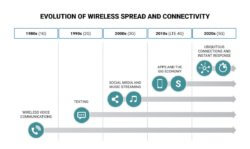
The movement between these stages has been exponential and accelerating. Under 3G, each wireless fidelity (Wi-Fi) access point accommodated 250 connections. That increased to thousands of connections with 4G access points and millions with 5G connection points.
5G introduces unprecedented speed, massive connectivity, unparalleled reliability, and near-zero latency (network response times to individual commands/clicks). Under 5G, everything will connect to everything else. This convergence of capacity, connectivity and capabilities will unleash another era of breakthrough tech-enabled innovations.
ATT’s Katibeh predicts that our toothbrushes will tell us when we’re about to get a cold. Smart phones will make instantaneous translations — no need to study foreign languages. Smart, always-on sensors will protect us. Bikes will connect with cars and stoplights to predict accidents and stop them before they happen.
As it will in all other industries, 5G will revolutionize healthcare. When combined with edge computing, 5G speed and connectivity will enable remote care at the speed of thought. 5G will make better doctors faster through augmented reality (AR) training and patient-specific overlays during surgeries.
Imagine platform companies harnessing the power of these new technologies to redesign and deliver health and healthcare services that meet consumers’ specific needs and preferences. This consumer-centric revolution in healthcare services is just over the horizon. It will come, however, with significant human and organizational dislocation.
Enhancing Human Potential
The emergence of electricity and the innovation it spawned propelled the United States from an agricultural to an industrial society. These advancements triggered wealth creation, urbanization and massive social dislocation. In response, American civil society introduced universal education, universal suffrage, income taxes, labor reform and social services to blunt capitalism’s “creative destruction.”
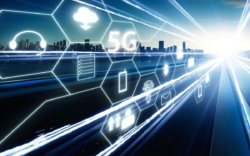
Revolutionary advances in technology will require societies to adopt new forms of organization to optimize performance and new regulatory support structures to protect citizens and promote fair competition. Change is difficult for human beings, organizations and societies. It is particularly difficult during periods of accelerated change. This was the core thesis that led Tom Friedman to write Thank You for Being Late: An Optimist’s Guide to Thriving in the Age of Accelerations.
In his 2016 book, Friedman describes a new age of relentless, accelerating change where everyone and everything is connected, and no one is in charge. He contemplates how simultaneous and interactive accelerations in technology, globalization and the environment affect people and cultures.
Seeking strategies for helping organizations and individuals adapt to this age of accelerations, Friedman interviewed Google’s Eric “Astro” Teller. Teller’s official title at Google X (the company’s research and development lab) is “Captain of Moonshots.” He also happens to be the grandson of Edward Teller, the inventor of the hydrogen bomb.
Healthcare providers need to leverage artificial intelligence (AI), machine learning (ML), natural language processing (NLP) and other technology tools to collect, curate and analyze massive data sets to improve care delivery, streamline administrative tasks, and glean insights that lead to new and better medicines, treatments and interventions.
For the first time in human history, Teller believes the rate of technological change is greater than human adaptability. This new reality is a profound source of human discontent. He uses the following chart to depict the challenge and illustrate potential solutions.
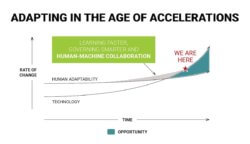
Source: Thank You for Being Late by Tom Friedman, page 34
Teller believes the only way for society to adapt to massive technological change is for individuals to learn faster and for public, private and governmental organizations to govern smarter. This requires smarter regulation, better education and adaptive organizational structures. Better systems and governance reduce friction while advancing the ability of front-line professionals to make better decisions in real time.
Extreme interoperability and associated technological innovations are increasing the rate of acceleration and human discontent that Teller describes. The current pace of change can feel overwhelming. However, technology now offers a new tool for adapting to Friedman’s “age of accelerations.” That tool is “human-machine collaboration.” It is very powerful.
In a 2018 Harvard Business Review article, authors H. James Wilson and Paul R. Daugherty describe the potential of “collaborative intelligence” as follows,
Never before have digital tools been so responsive to us, nor we to our tools. While AI will radically alter how work gets done and who does it, the technology’s larger impact will be in complementing and augmenting human capabilities, not replacing them.[5]
For better or worse, Friedman’s self-described age of accelerations is actually accelerating. Business models are adapting. The emergence of platform companies that incorporate breakthrough data technologies represents a new form of organizational evolution.
Increasingly, organizational competitiveness is becoming a function of aggregating, analyzing and applying social, environmental and consumer-specific data to commercial interactions. Platform companies are built to do exactly this. Liquid data and extreme interoperability are the lifeblood that sustain platform companies in their quest to differentiate their service offerings.
As with natural selection, companies that survive will be those that develop platforming capabilities, continually experiment, discover innovative business practices and integrate them quickly into operations. Engaging consumers, earning their loyalty and executing their transactions creates demand for more services and establishes “market fitness,” the ultimate determinant of organizational success and sustainability.
Liquid Data and COVID-19
Imagine how different the national and international responses to COVID-19 would have been with free- flowing data, extreme interoperability, massive connectivity and full-on augmented intelligence. Here’s what we may have seen:
- Quickly pinpointing the disease origins.
- Faster identification of those infected with the virus.
- The ability to trace through technology (smart phones, smart watches, etc.) who may have come into contact with an infected person.
- Easier identification of at-risk populations based on demographics, disease factors and environmental conditions.
- Better distribution of vital medical supplies to those areas affected the most (testing kits, ventilators, protective gear, etc.).
- Advanced predictive models that could predict the highest risk areas and logistics that deliver vital supplies in anticipation of their needs.
- Ongoing monitoring of the general population for signs of infection (e.g., decreases in oxygen levels).
- Smart phone apps that clear individuals for social interaction.
- Accelerated creation of treatments tailored to individual genetic profiles.

There are start-ups just beginning to harness this information, and there is promise for improved surveillance reporting. For example, BlueDot emerged as a global early warning system for infectious disease by being among the first companies in the world to identify the emerging risk from COVID-19 in Hubei province.[6] CMS, ONC and OIG have all released guidance concerning compliance with the interoperability final rules in the face of the COVID-19 public health emergency.[7] This pandemic will help accelerate new solutions, technologies and companies that will focus on real time data-driven insights.
Without liquid data, we have applied mass scale tactics impacting the general population (e.g., social distancing) to stall the spread of the disease and manage patient volume. With liquid data, society potentially could have identified the disease earlier, which in turn could have allowed us to limit its spread, find effective medical interventions more quickly and avoid or limit economic disruption.
Revolutionized Healthcare
Healthcare is not immune from the accelerating forces described by Tom Friedman. Liquid data with extreme interoperability is recreating today’s world with the same ferocity that electricity applied to initiate the industrial age. Resisting this new technological age is akin to fighting gravity. Possible for a short time but impossible long-term.

Unfortunately, healthcare lags behind other industries in developing platform capabilities to use liquid data to advance outcomes, efficiency and value. These new market forces, with support from policies like those reflected in the new data-sharing rules, will drive healthcare organizations to use liquid data to provide better, more personalized care services.
As healthcare organizations adopt business models built around consumer-centric platforms, market power will shift away from payers and providers to consumers. Consumers will make more healthcare purchasing decisions. Their demand-driven purchasing will revolutionize healthcare delivery in the same dramatic ways that they’ve revolutionized almost all other industries from banking to telecommunications.
This shift toward healthcare consumerism will place greater emphasis on prevention, early diagnosis, holistic treatment and well-being. While beneficial to consumers, this shift will diminish the market relevance of traditional health companies that rely on expensive, centralized and inefficient operations.
The industrial age welcomed cars and punished buggy-whip manufacturers. In the age of liquid data, platform-based healthcare companies that deliver the right care, at the right time, in the right place and at the right price will prosper. Those that deliver noncompetitive healthcare services will falter.
Convergence is happening. Powered by liquid data, revolutionized healthcare is already here, growing fast and getting better.
Extreme interoperability gets the right data to the right place at the right time in the right format, so that frontline professionals can make the right treatment decisions in real time.
Sources
- https://www.hhs.gov/about/news/2020/03/09/hhs-finalizes-historic-rules-to-provide-patients-more-control-of-their-health-data.html
- https://www.forbes.com/sites/bernardmarr/2018/05/21/how-much-data-do-we-create-every-day-the-mind-blowing-stats-everyone-should-read/#1cb2ba0460ba
- https://www.grownemttogether.com/
- https://www.youtube.com/watch?v=EccF6jR3CFo
- https://hbr.org/2018/07/collaborative-intelligence-humans-and-ai-are-joining-forces
- https://bluedot.global/
- https://www.hhs.gov/about/news/2020/04/21/statements-from-onc-cms-on-interoperability-flexibilities-amid-covid19-public-health-/index.html
Co-author:
 Jeff Jones serves as Chief Commercial and Strategy Officer for Conifer Health Solutions. In this role, he defines the strategic direction for Conifer including the enterprise strategy, strategic partnerships, leads all commercial activities, heads client service and delivery, owns brand, marketing and go to market strategy, and directs new solution innovation. Jeff joined Conifer’s Executive Leadership Team in September 2019 bringing with him over 30 years of industry experience.
Jeff Jones serves as Chief Commercial and Strategy Officer for Conifer Health Solutions. In this role, he defines the strategic direction for Conifer including the enterprise strategy, strategic partnerships, leads all commercial activities, heads client service and delivery, owns brand, marketing and go to market strategy, and directs new solution innovation. Jeff joined Conifer’s Executive Leadership Team in September 2019 bringing with him over 30 years of industry experience.
Jeff’s experience in both the healthcare and technology industries coupled with his demonstrated track record partnering with health systems, academic medical centers, specialized providers, medical groups and health technology companies allows him to bring unparalleled insights into Conifer’s overall business.






